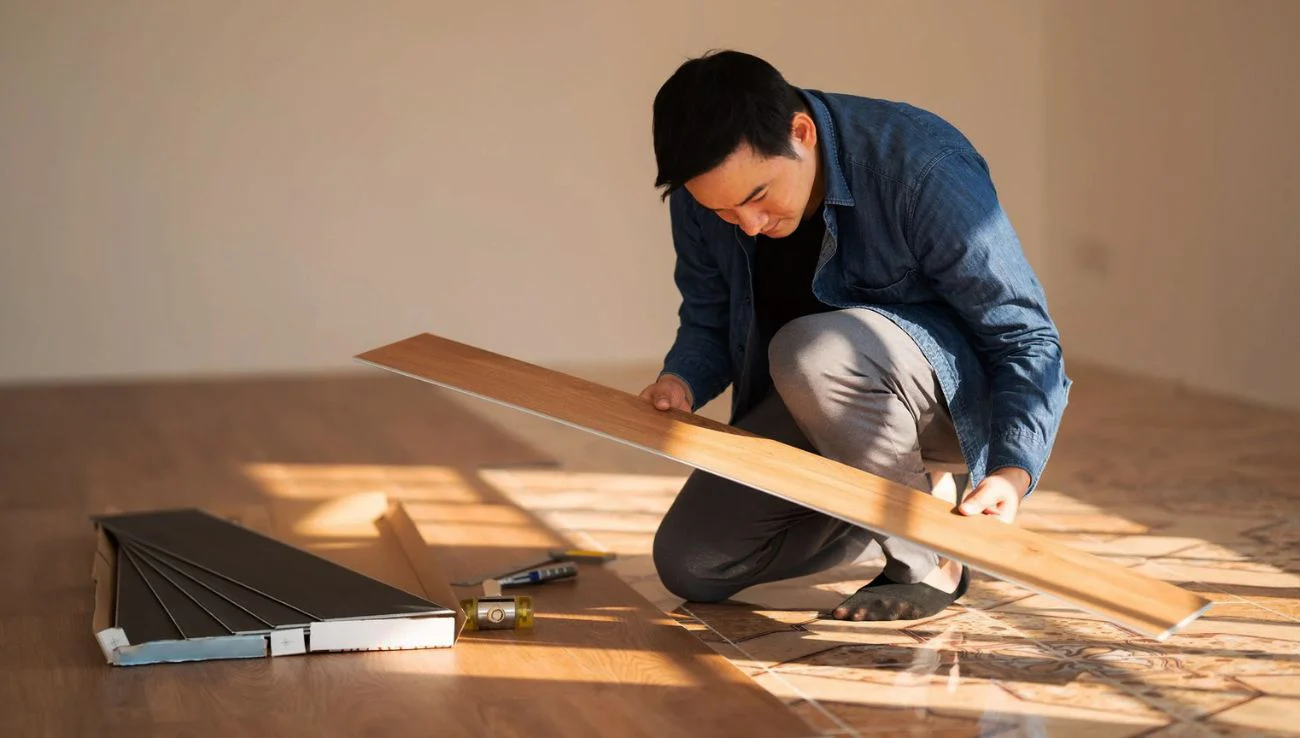Tutorial on Installing Laminate Floors
Everything you need to know to lay laminate flooring is included in this article, from the specific steps to take to the comprehensive list of tools and materials you’ll need.

Is Laminate Flooring Worth the Money?
Is it your goal to learn more about installing laminate flooring in your house?
Here, you’ll find detailed instructions for installing laminate flooring, as well as a comprehensive list of the equipment and supplies you’ll need to get the job done.
Putting up laminate flooring could be a good idea for a variety of reasons. Laminate flooring is an option to consider if your current flooring is beginning to show signs of wear and tear.
The advantages of installing laminate flooring in your home are as follows:
- The set-up is simple.
- It can withstand both water and scratching.
- It requires little effort to keep tidy.
- Choices in colour and style are plentiful.
DIY: Laminate Flooring Installation
How to install laminate flooring is outlined in detail below. You should always refer to the manufacturer’s directions when installing laminate flooring because each kind is slightly different.
Step 1: Planning
You should start with a layout. Vertical or horizontal installation of laminate flooring is possible, so try both and see which you like best!

Layout your boards so that the last row is at least 60mm wide. If necessary, you can widen the first row. Don’t forget to provide for a space of 12mm at both the beginning and the end of the room.
Step 2: Cut to size
The second step is to remove the door if you’ll be installing the laminate around a door frame, and then to align an offcut of underlay and a floorboard with the architrave.

Cut the architrave to size using a panel saw. The architrave’s underside must be trimmed down to size before the laminate can be installed.
Step 3: Layers
Third, before installing your laminate flooring, most manufacturers advise using a foam or fibreboard underlay. This needs to be oriented at a right angle to the lamination.

Step 4: Installing Laminate Plank
After the underlay is in place, begin installing the laminate flooring by placing the first piece against the wall on the left (where the door is).

You’ll need to shift the board slightly to make room for the spacers you’ll be placing between it and the walls.
Step 5: Pressing
Place the next board over the end of the previous one and press down until you hear a click. Take care to use spacers to preserve the expansion gap along the wall.

Step 6: Alignment
Follow this procedure along the wall until you reach the end and the boards are touching each other.

Step 7: Drawing line
A whole board should be set down parallel to the already-laid boards to fill in the last bit of space. Invert the board so that the groove edge is still facing you, but the opposite end is resting on the wall spacer.

Using the end of the piece as a guide, draw a straight cutting line. Cut the board to size after safely securing it to your workbench. This final piece can be laid in the same manner as the rest of the set to conceal the gap.
Step 8: Starting next row
Use the offcut to begin the second row at the same end as the first row if it is at least 300mm long.

Spread out the laminate boards and click each row into position with the one next to it, leaving the same number of spacers between the rows and the wall. Joints between boards in adjacent rows should be staggered by at least 300 mm.
Step 9: Measuring the distance
The space between the first row and the entranceway must be filled in after Step 9. To begin, determine how far apart the architrave is on both sides of the door.
The distance from the front row to the exit should then be calculated. Make a cutting guide using these dimensions. Always leave a 12mm expansion gap at the very end.

Then, set the board with its cut edges against the architrave and make a mark at each end. Make your cuts at the marked locations, and then move the top two rows out of the way to install the door panel(s).
Step 10: Laying parallel
The tenth step is to attach this section to the initial row by clicking it into position. After that is complete, continue laying the rows of laminate flooring, making sure to leave a spacer gap at the walls between each row.

Step 11: Precise measurements
In order to make the boards fit in the last row, you may need to make some adjustments to their length. Make sure to provide a 12mm expansion margin when measuring and marking the boards. Use the provided measurements to guide your cutting, and then insert the last row.

As was previously noted, different laminate flooring options may require a different method of locking together during installation. Before beginning any project, it is imperative that you verify the manufacturer’s guidelines.
Useful tools to lay laminate
The equipment needed to install laminate flooring is detailed below.
- A measuring tape
- Panel saw with a fine-toothed pencil
- The Use of a Jig Saw
- Spacers for the Floor
- Clamps
- Squared-off Workbench Consolidation
- Hammer and Chisel
- Straight edge or metal ruler
- Folding blade knife
- Flat 32mm drill bit for wood
- Square mitre
- Laminate Flooring Installation Safety Gear for Planes
- For the installation of laminate flooring, you will require the following safety tools:
- Protective eyewear
- The need for a dust mask
- Guards for the knees
- Supplies Needed to Install Laminate Floors
- To lay laminate flooring, you’ll need these items:
- Faux-wood plank flooring
- Membrane or underlay
- Moulding for Floors
- Stick to it
- Nails for the back of panels
- Armoring of a pipe
- Limitation marker
- To protect furnishings, use felt pads.
Tips on Getting Ready to Install Laminate Flooring
Getting ready to lay laminate flooring begins with clearing the space of all existing fixtures, furniture, and other obstructions. Before installing new flooring, remove the old flooring and give the area a good vacuum.
Look for nails that are sticking up or areas of the floor that aren’t level, as these will need to be fixed before installation can begin.
Before beginning the work, make sure the floor is dry. Laminate should be stored in the room where it will be laid for at least 48 hours before it is opened.
Flooring Laminate Varieties
Laminate flooring can be split into two categories. Details about each category are provided below.
A laminated Plastic
Laminate flooring is completely synthetic and manufactured by imitating the look of wood by printing an image onto the surface.
The printing is then covered with a protective coating. Laminate flooring can be made to look quite similar to real wood, but most people can tell the difference when they look more closely.
Laminate made from synthetic wood
The cost of plastic laminate is substantially lower than that of engineered wood laminate. A longer lifespan is possible with careful maintenance.
This fake wood is a lot closer to the genuine thing. The process included adhering a real hardwood veneer on a plywood base. This makes the floor look like solid wood without the astronomical cost.
FAQs
Laminated floors are easy to maintain.
Most types of laminate flooring can be cleaned using a solution of water and vinegar. Try not to get the floor too soggy by using a damp mop.
Use a moist cloth to quickly and thoroughly clean up any minor spills. Regular sweeping will keep the floors clean and tidy.
Where do you start when installing laminate flooring around a pipe?
To avoid damaging the piping when installing laminate flooring, follow these steps:
Don’t worry about the pipe; just use your regular measuring and cutting techniques.
You can use a tri-square to mark the centre of the pipe on the board by laying it on one side of the pipe and drawing a line.
The next step is to bring the board in front of the pipe and mark its centre with a line. The pipe will go in the middle of the intersection of the two lines.
Clamp the board down and drill a hole using a 2mm flat wood drill bit at the intersection of the two lines.
With a straight edge, connect the hole’s outer edges to the board’s outer edge at an outward angle.
Follow these guides as you cut along a jig saw or panel saw.
Position the board where it will stay, then glue the scrap and slide it into place.
A radiator pipe cover can be used to conceal the gap caused by expansion. You can secure it in place with adhesive.
Putting in a threshold bar: how do you do it?
Select a threshold bar that works with your floor type. Take the dimensions of the doorway and add some extra space on either side for growth.
Then, reduce the size of the current threshold. The threshold bar must then be fastened as directed by the manufacturer.
How do you install trim around a floor?
Take out the separators and trim the membrane to size. Get out a measuring tape and figure out what size flooring trimmings you’ll need.
Cut the ends of the trim at 45-degree angles with a mitre box and saw so they can be inserted into the corner joints.
The flooring trim can be attached to the skirting with the help of grab adhesive. The laminate floor will expand if the trim is not fastened to the floor.
What is the most desirable quality in laminate flooring?
It really is up to you. There are a wide variety of laminate flooring options available to suit everyone’s preferences.
Before settling on a laminate floor, it’s a good idea to do some research to ensure you locate one you like.









